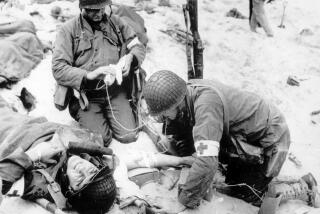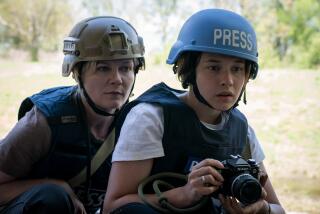Legacy of the Blue and the Gray
- Share via
FREDERICK, Md. — A bullet ripped into Richard Brown’s left thigh, and as the 21-year-old Confederate cavalryman struggled to stay mounted, his horse fell on him, snapping the same leg’s thigh bone.
Medically, even with the compound fracture, the bullet wound likely would not be life-threatening today. But this was a hot, muggy Friday in September 1862. For nearly two months, Brown suffered in a Union hospital in the old Hessian barracks that still stand at the Maryland School for the Deaf. On Nov. 7, he died.
Private Brown’s black and white photograph stares out at visitors from a wall in the new National Museum of Civil War Medicine here. His story is a newly recognized footnote in American medical history, told in a Civil War museum unlike any other.
Rather than concentrating on battles, or slavery, or Blue and Gray, this museum is about an unheralded result of that war that former Surgeon Gen. C. Everett Koop calls “a watershed in the history of medicine.”
Many museums focus on the Civil War and its battles, but what happened to its 620,000 dead and even more wounded gets only passing mention.
“What we take for granted in medicine today started then,” says Dr. Gordon E. Dammann, a dentist in Lena, Ill., who came up with the idea for the museum. “Before the war, American medicine was looked down on by the rest of the world. After the war, we quickly became the leader.”
Forced to cope with rampant illness and horrible wounds numbering in the tens of thousands, doctors with little in the way of modern knowledge or technology experimented, improvised and invented. The list of advances taken for granted today is impressive:
Better sanitation practices, modern hospitals, nursing as a profession, wide use of anesthetics, the triage system of treating the injured, mobile surgical units--all have Civil War roots.
In the process, doctors saved many like Carlton Burgan, whose photograph hangs next to Richard Brown’s on the museum wall.
Burgan was a Union foot soldier, just 18, when a cold turned into pneumonia in Winchester, Va. Today, antibiotics, nourishment and rest would quickly return him to normal. But he survived this Civil War reality: For every soldier that bullets and shrapnel killed on the battlefields, two died of disease--ranging from childhood maladies such as measles to the more serious malaria, diphtheria and typhoid.
Burgan’s well-intentioned doctor, who knew nothing about germs or antibiotics, treated him with “calomel,” a mercury-based potion intended to make him salivate and, thus, flush his body of “bad humors.”
It was common practice 134 years ago. No one knew that mercury was a toxin. So the “remedy” ate away much of the soft tissue inside the young soldier’s mouth, not to mention his jawbone, right cheekbone and eye, and part of his nose.
A “before” photo of Burgan’s disease-eroded face reminds you of a grotesque Popeye in extremis. “After” is where his story surprises.
His face has been restored to near-normal dimensions and features, though thickly scarred with Frankensteinesque seams where live tissue was stitched to cover a reconstructed jaw, cheek and nose. Gurdon Buck, the New York doctor who did the work, is regarded as the father of modern plastic surgery.
Add a happy ending: Burgan was discharged from the Army, married and had “many” children before dying at age 71 in 1915.
Stories that personalize the war this way--for soldiers and doctors alike--accompany many of the 3,000 medical tools, devices, kits, packages, medicines, accouterments and rare documents collected by Gordon Dammann. This material constitutes the private, nonprofit museum’s starting point.
Frederick was chosen for its location because the city actually was a major wartime medical center--central to major battles at Gettysburg, Antietam, Harper’s Ferry, on the Monocacy River, all along South Mountain, and south into the Shenandoah Valley. No fewer than 29 churches, schools and other buildings in Frederick, many near today’s museum, served as hospitals at some point during the war.
Go ahead, cynics, call a positive spin on a time better known for medical practices bordering on the barbaric reconstructive history. Because everyone has read about and in movies has seen the Civil War’s “surgeons,” who left behind more than 50,000 legs and arms amputated at various battlegrounds. But even with only a few of Dammann’s items on display now, the museum’s exhibits reshape such skepticism without sugarcoating the obvious. In fact, the museum’s goriest element, discretely played over-and-over on videotape next to a reconstructed field hospital, is a chillingly realistic leg amputation concocted by Civil War reenactors.
But, you learn that even under the best of conditions, those so-called “sawbones” doctors could not beat infections, including deadly gangrene. Europeans such as Joseph Lister were only on the verge of discovering germs. So amputation was quick--three to five minutes in many cases--and while not without risk, a much better wager on life than leaving the patient to die, almost certainly, from infection or blood loss.
You also learn quickly in touring just the one floor (out of three planned) what other medical changes that are taken for granted in the 1990s grew out of the war.
Not least was public sanitation--systematized cleanliness, separating latrines from water and food in campsites, for example. Early in the war, chronic diarrhea was a major killer as well as spreader of disease.
“The concept of hospitals as places to cure patients, not to just let them die, was another major development,” points out Burton K. Kummerow, the museum’s executive director. “We’ve given that gift to the world.”
Before the war, the only hospitals had been “pest houses,” charitably run places where people with contagious diseases such as tuberculosis, pneumonia and smallpox were isolated to die. Critically ill indigent ended life warehoused in comparable “poorhouses.”
Because of the war’s overwhelming numbers of wounded and ill, “pavilion” hospitals--airy, easy-to-clean, designed with central nursing stations and common corridors used today--evolved.
By war’s end, the Confederate Chimborazo Hospital just east of Richmond, Va., was the reunited nation’s largest, with about 8,000 beds. The Union, which began the war with only one 40-bed military infirmary, that one in Kansas, ended it with 181,000 hospital beds.
(BEGIN TEXT OF INFOBOX / INFOGRAPHIC)
GUIDEBOOK
Medicine Museum
The National Museum of Civil War Medicine is at 48 E. Patrick St. in Frederick, Md. Hours: 10 a.m.-5 p.m. Tuesdays through Fridays, noon-5 p.m. Saturdays and Sundays. (Beginning March 15, the museum will be open daily.) Telephone (301) 695-1864. Admission: recommended donation $2.50 per person. A gift shop is on the premises.
More to Read
Sign up for Essential California
The most important California stories and recommendations in your inbox every morning.
You may occasionally receive promotional content from the Los Angeles Times.










